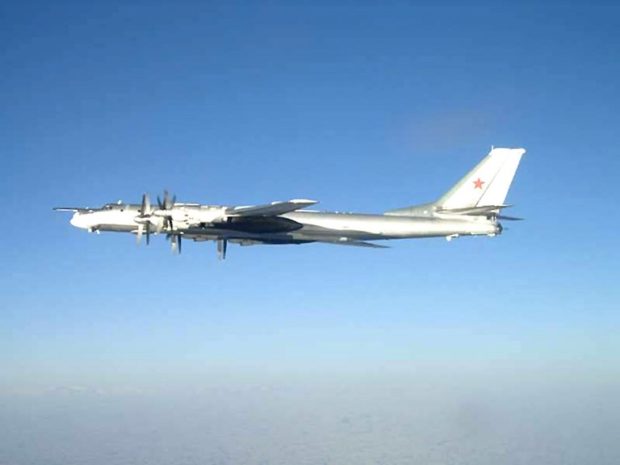Russian bombers enter US air defense zone, intercepted

This image released by the US Navy on February 12, ,2008 shows a Russian Tu-95 Bear long-range bomber. AFP FILE
WASHINGTON, United States — US fighter jets intercepted two long-range Russian “Bear” bombers in international airspace off western Alaska, the North American Aerospace Defense Command said Saturday.
The long-range Tupelev Tu-95 bombers were “intercepted and visually identified” Friday morning by a pair of F-22 Raptors as the Russian aircraft flew just north of Alaska’s Aleutian islands, said Canadian Army Major Andrew Hennessy, of NORAD public affairs.
“At no time did the Russian bombers enter North American sovereign airspace,” Hennessy said in a statement to AFP.
He added that the Alaska-based US jets monitored the Russians until the bombers left an area known as the Air Defense Identification Zone along the Aleutians, heading west.
That zone extends about 200 miles (322 kilometers) from the coastline, mostly in international airspace.
Article continues after this advertisementSaturday marks the 60th anniversary of the founding of NORAD, a joint US-Canadian command charged with aerospace warning and control for North America.
Article continues after this advertisementIn April 2017, NORAD and the Pentagon said Tu-95 “Bear” bombers — four-engine Cold War-era turboprop giants that can carry nuclear weapons — were spotted in international airspace on three occasions — twice near the Aleutians and once near mainland Alaska and Canada.
That was the first sighting of such Russian long-range bombers around Alaska in about two and a half years, a Pentagon spokesman said at the time.
‘Unsafe’ interception
Tensions between Russia and the United States and its NATO allies are running at levels not seen since the Cold War.
The Alaska incident comes after a Russian Sukhoi Su-27 fighter jet buzzed a US Navy P-8 Poseidon surveillance plane in international airspace over the Baltic Sea, US media reported, citing the US Navy.
Earlier, on January 29, the US Navy released video of a Russian Su-27 intercepting a US EP-3 Aries surveillance plane in international airspace over the Black Sea.
The interception, which lasted two hours and 40 minutes, was “unsafe” because the Russian jet was “closing to within five feet and crossing directly” through the surveillance plane’s flight path, “causing the EP-3 to fly through the Su-27’s jet wash,” the US Navy said in a statement.
NATO naval officials in late 2017 also reported Russian submarines probing underseas data cables in the North Atlantic.
US Defense Secretary Jim Mattis said in January, as he unveiled the Pentagon’s national defense strategy, that the United States is facing “growing threats” from Russia and China, and he warned that the US military’s advantages have eroded in recent years. /cbb